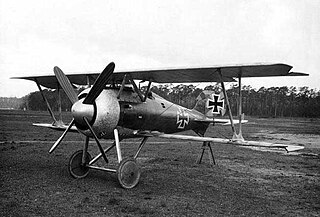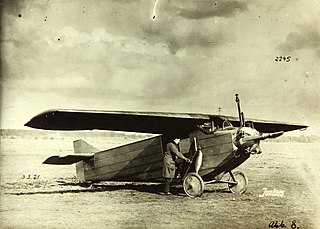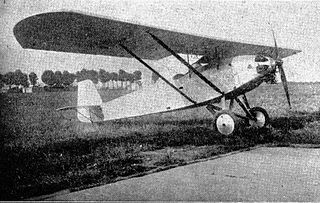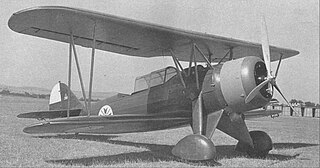Operators
 Bulgaria
Bulgaria
- Kazanlak Air School [1]
 Yugoslavia
Yugoslavia
| DAR 9 Siniger | |
|---|---|
| Role | Sport Trainer |
| National origin | Bulgaria |
| Manufacturer | Darzhavna Aeroplanna Rabotilnitsa (DAR) |
| Introduction | 1940 |
| Number built | 42 |
| Developed from | Focke-Wulf Fw 44 Stieglitz |
The DAR-9 Siniger, was a trainer produced in Bulgaria during World War II.
To provide the Bulgarian Air Force with a modern trainer, DAR took out a licence to build the Focke-Wulf Fw 44J. The first series, powered by a Siemens-Halske Sh 14 radial engine, was built at the DAR factory, but subsequent series were built at the DSF ( Derzhavna Samoletna Fabrika ) [1]
Surviving aircraft in 1948 were re-engined with Walter Minor 6.III inline engines due to difficulty in procuring spares and the poor condition of the Siemens-Halske engines. [1]
DAR 9 production consisted of the series 1, which was built at the DAR factory and which carried the construction numbers 88 to 93 and Series 2 to Series 5, built at the DSF factory and which carried construction numbers 95 to 130. [1]
The DAR 9s were used for training at the Kazanlak Air School until at least 1949. Nine surplus DAR 9s were transferred to the Yugoslavian Air Force in 1947, withdrawn from service by 1958. [1] One DAR 9 is preserved at the Technicki Muzej, Zagreb, Croatia.
General characteristics
Performance

The Focke-Wulf Fw 44 Stieglitz ("Goldfinch") is a 1930s German two-seat biplane. An early design by Kurt Tank, it was produced by the Focke-Wulf company as a pilot training and sports flying aircraft. It was also built under license in several other countries.

The Messerschmitt Bf 108 Taifun was a German single-engine sport and touring aircraft, developed by Bayerische Flugzeugwerke in the 1930s. The Bf 108 was of all-metal construction.

The Siemens-Schuckert D.IV was a late-World War I fighter aircraft from Siemens-Schuckert (SSW). It reached service too late and was produced in too few numbers to have any effect on the war effort.

VL Viima, constructed by the State Aircraft Factory is a Finnish two-seat, biplane trainer used by the Finnish Air Force from the late 1930s to the early 1960s. After military service, several were released into civil use.

The Heinkel He 72 Kadett ("Cadet") was a German single-engine biplane trainer of the 1930s.

The Bücker Bü 133 Jungmeister was an advanced trainer of the Luftwaffe in the 1930s. It was a single-engine, single-seat biplane of wood and tubular steel construction and covered in fabric.

The Arado S I was a biplane trainer built in Germany in 1925. The first of three prototypes was powered by a Bristol Lucifer radial engine, while the other two Arado S.Ia aircraft were fitted with the Siemens-Halske Sh 12. The Siemens-Halske Sh 11 powered the Arado S III, a virtually identical aircraft of which only a single prototype was constructed and sold to Turkey.

The Udet U 12 Flamingo was an aerobatic sports plane and trainer aircraft developed in Germany in the mid-1920s.

The Siemens-Schuckert D.I was a single-seat fighter built by Siemens-Schuckert Werke in 1916. It was a German copy of the French Nieuport 17 that was obsolete by the time it was available in numbers, so that it served mainly as an advanced trainer.

The Siemens-Schuckert D.III was a German single-seat fighter built by Siemens-Schuckert Werke. The D.III was a development of the earlier Siemens-Schuckert D.IIc prototype. The D.III was an (nearly) equal-span biplane powered by a 160 hp (119 kW) Siemens-Halske Sh.III bi-rotary engine. Idflieg placed an order for 20 aircraft in December 1917, followed by a second order of 30 aircraft in February 1918.

The Dornier Libelle, also designated Do A, was a German open-cockpit, all-metal, parasol wing, monoplane flying boat aircraft, with partly fabric-covered wings. A landplane version, built without sponsons and fitted with a fixed tailwheel undercarriage was produced as the Dornier Spatz.

The Junkers K 16 was a small airliner produced in Germany in the early 1920s. It was a conventional, high-wing cantilever monoplane of all-metal construction, equipped with fixed, tailwheel undercarriage. The pilot sat in an open cockpit, while the two passengers were provided with an enclosed cabin within the fuselage. Shortly after the prototype flew, aircraft production in Germany was brought to a complete halt by the Allies, and the K 16 was quickly evacuated to the Netherlands to avoid confiscation. There, it was stored by Fokker until the restrictions were relaxed and work recommenced at Junkers' Dessau factory in 1924. By this time, however, the airline niche that the tiny K 16 had been intended to fill no longer existed, and the small number that were produced were mostly sold to private owners. Junkers entered two K 16s in the 1925 Deutsche Rundflug, with one machine winning second place in the competition.

The Siemens-Schuckert E.I was a German fighter aircraft, manufactured by Siemens-Schuckert.

The DAR 1 Peperuda (butterfly) was a 1920s Bulgarian two-seat touring or trainer biplane, designed by Hermann Winter and built by the DAR – Drjavna Aeroplane Rаbotilnitsa – State Aircraft Workshops.

The Rogožarski SIM-X was a Yugoslav single-engine sports and tourist plane also used for basic training of military pilots designed in 1936, with two crew members. It was designed and built at the Rogožarski factory in Belgrade.

The Rogožarski SIM-XI was a single-seat, single-engine trainer monoplane built in the Kingdom of Yugoslavia in 1938. It was designed and built at the Rogožarski factory in Belgrade.
The SIM-VIII was a 1931 Yugoslav, single-engined, 2-seat, sport, tourist and training aircraft, designed by Sima Milutinović and built at the Rogožarski factory in Belgrade from 1931 and by Ikarus at Zemun from 1933.

The SIM-II was a 1930s Yugoslav Sports and tourist plane and the plane for the basic training, one-engined, with two crew members. It was designed by Sima Milutinović and built at the "S.Vlajković i sinovi" factory in Belgrade.

The Darmstadt D-29 was a German experimental monoplane designed and built by Akaflieg Darmstadt. The D-29 was a cantilever low-wing monoplane designed and built during 1936 with a conventional landing gear with a tailskid. It was powered by a Siemens-Halske Sh 14a radial piston engine and had enclosed tandem cockpits, as well as a number of other features, including hydraulically actuated trailing-edge flaps, a braced T-tail and leading-edge slots.

The DAR 3 Garvan was a 1930s Bulgarian single-engine, multipurpose reconnaissance and auxiliary aircraft.